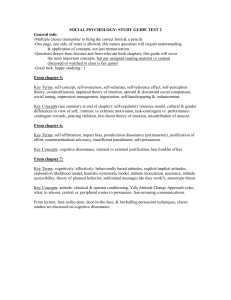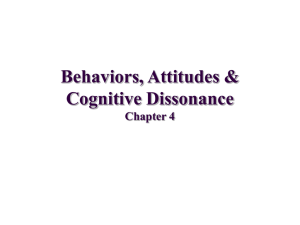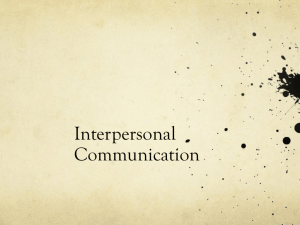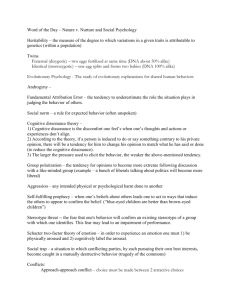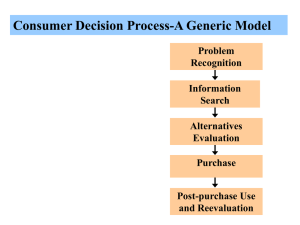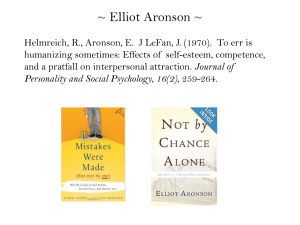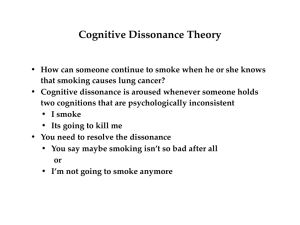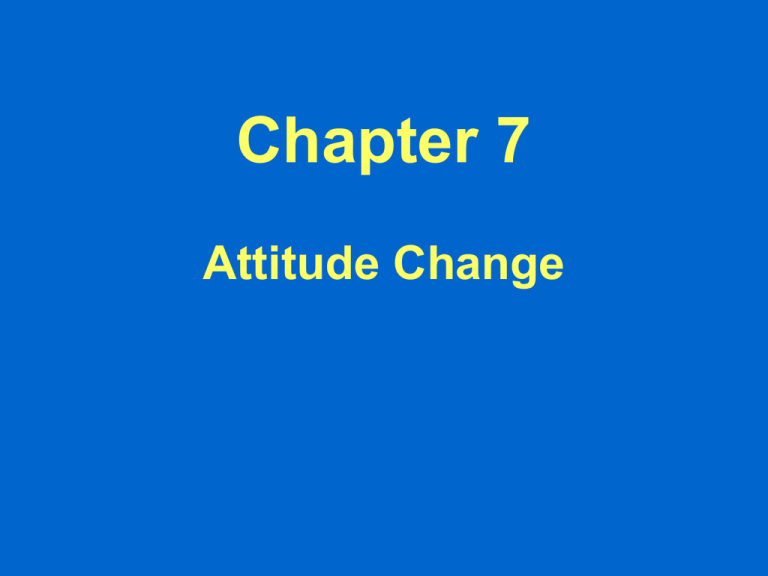
Chapter 7
Attitude Change
In a study by Zimbardo et al. (1965), participants were asked to eat a fried
grasshopper by either an extremely polite and pleasant experimenter or a
cold and unpleasant experimenter. About 50% of the participants
in each condition ate the grasshopper, but those asked to do by the
unpleasant experimenter:
1.
2.
3.
4.
rated the grasshoppers more favorably.
ate the grasshopper when asked to do
so by the polite experimenter, but only
10% did so when asked to do by the
unpleasant experimenter.
in each condition ate the grasshopper,
but those asked to do so by the pleasant
experimenter rated the grasshoppers
more favorably.
ate the grasshopper when asked to do
so by the unpleasant experimenter, but
only 10% did so when asked to do by
the pleasant experimenter.
25% 25% 25% 25%
1
2
3
4
Rationalization is a way to reduce the aversive
arousal of cognitive dissonance by:
1.
2.
3.
4.
convincing ourselves that our
current or past behaviour
made sense after all.
changing our behaviour to be
more consonant with our
cognition.
adding a consonant
cognition.
All of these are true.
25% 25% 25% 25%
1
2
3
4
In Festinger and Carlsmith’s (1959) experiment on
cognitive dissonance, what variable did the
experimenters manipulate to induce dissonance?
1.
2.
3.
4.
the tasks completed by the
participants were either exciting or
boring
the tasks completed by the
participants took either an hour or
15 minutes to complete
the participants was paid either $1
or $20 to tell a confederate that the
tasks were exciting
the participants were asked to tell a
confederate that the tasks were
either exciting or boring
25% 25% 25% 25%
1
2
3
4
How did the researchers in the Aronson and Mills (1959)
experiment on cognitive dissonance manipulate the amount
of effort that participants had to endure to join a sexual
discussion group?
1.
2.
3.
4.
Participants had to pledge either $1 or $5 to
join the group.
Some participants had to read out loud a list
of obscene words and detailed descriptions of
sexual activity, whereas others had to read
out loud more ordinary words.
Some participants had to describe their actual
sexual experiences, whereas others had to
describe their sexual fantasies.
Some participants had to write a
counterattitudinal essay on premarital sex,
whereas others had to write an essay on the
same topic that was consistent with their
attitude.
25% 25% 25% 25%
1
2
3
4
The tendency for people to rate the chosen item more
favorably and the rejected item less favorably after a
decision has been termed:
1.
2.
3.
4.
spreading of the alternatives.
effort justification.
a preference for consistency
(PFC).
heuristic processing.
25% 25% 25% 25%
1
2
3
4
Which of the following best summarizes the textbook’s
conclusion about alternatives to dissonance theory?
1.
2.
3.
4.
Each alternative has a kernel of truth, but selfaffirmation theory explains most of the research
conducted by dissonance researchers as fully as
dissonance theory does.
Each alternative has a kernel of truth, but
dissonance theory still explains most of the
research conducted by dissonance researchers.
Self-perception theory and self-affirmation theory
have no substantial empirical support, but
impression management theory can explain most
of the dissonance results better than dissonance
theory.
Self-perception theory and impression
management theory have no substantial empirical
support, but self-affirmation theory can explain
most of the dissonance results better than
dissonance theory.
25% 25% 25% 25%
1
2
3
4
Research on cultural differences in dissonance arousal has
shown that people in collectivist cultures experience
dissonance when:
1.
2.
3.
4.
they make a choice for
someone else.
they make a choice for
themselves.
All of the above.
None of the above.
25% 25% 25% 25%
1
2
3
4
When running for mayor of a city, a candidate uses an advertising
campaign that describes her positions on important issues and
praises her integrity, honesty, and patriotism. This is an example of
the ____ in advertising.
1.
2.
3.
4.
soft sell
hard sell
deceptive practices
peripheral route to persuasion
25% 25% 25% 25%
1
2
3
4
____ occurs when people rely on cues to make judgments
about the message, without thinking carefully about the
arguments that are presented.
1.
2.
3.
4.
Systematic processing
Inoculation
Cognitive dissonance
Heuristic processing
25% 25% 25% 25%
1
2
3
4
In a study by Hafer et al. (1996), which tested college students’ responses to a
persuasive message on plea bargaining, the complexity of the message was
manipulated: the arguments were stated either in clear and straightforward
language or in complex and difficult to understand language. Among these four
conditions, which led to more attitude change in favor of plea bargaining?
1.
2.
3.
4.
when the message was difficult to
understand and the credibility of the source
was low
when the message was difficult to
understand and the credibility of the source
was high
when the message was easy to understand
and the arguments were weak
when the message was easy to understand
and the credibility of the source was high
25% 25% 25% 25%
1
2
3
4
According to _______ theory, threatening messages must
convince recipients that a problem is serious, they are
susceptible, and the recommended behaviours will be
effective in order for behaviour to change.
25% 25% 25% 25%
1.
2.
3.
4.
protection motivation
fear enhancement
dissonance
elaboration likelihood
1
2
3
4
The powerful technique that cults use to shower potential
recruits with physical affection, flattery, and unconditional
caring and security is called:
1.
2.
3.
4.
the foot-in-the-door technique.
love-bombing.
affect inoculation.
brainwashing.
25% 25% 25% 25%
1
2
3
4
When cults seek recruits, what age group do
they target?
1.
2.
3.
4.
18 to 30 years old.
15 to 20 years old.
30 to 40 years old.
25 to 35 years old.
25% 25% 25% 25%
1
2
3
4
Propaganda is a persuasive attempt that is:
1.
2.
3.
4.
motivated by an ideology.
deliberately biased in its
presentation
Both of the above.
None of the above.
25% 25% 25% 25%
1
2
3
4


